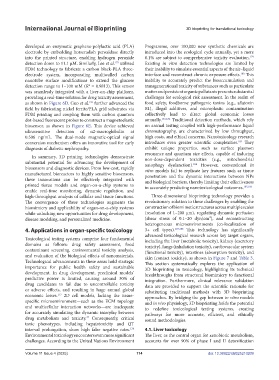Page 122 - v11i4
P. 122
International Journal of Bioprinting 3D bioprinting for translational toxicology
developed an enzymatic graphene-polylactic acid (PLA) Programme, over 100,000 new synthetic chemicals are
electrode by embedding horseradish peroxidase directly introduced into the ecological cycle annually, yet a mere
into the printed structure, enabling hydrogen peroxide 0.1% are subject to comprehensive toxicity evaluation.
179
detection down to 11.1 μM. Similarly, Lee et al. utilized Existing in vitro detection technologies are limited by
175
FDM technology to fabricate a carbon black-PLA three- their inability to simulate essential aspects of the air–liquid
electrode system, incorporating multiwalled carbon interface and reconstruct chronic exposure effects. This
180
nanotube surface modifications to extend the glucose inability to accurately predict the bioaccumulation and
detection range to 1–100 mM (R = 0.9813). This sensor transgenerational toxicity of substances such as particulate
2
was seamlessly integrated with a liver-on-chip platform, matter and persistent organic pollutants presents substantial
providing a real-time solution for drug toxicity assessment, challenges for ecological risk assessment. In the realm of
as shown in Figure 6D. Guo et al. further advanced the food safety, foodborne pathogenic toxins (e.g., aflatoxin
176
field by fabricating nickel ferrite/PLA grid substrates via B1), illegal additives, and microplastic contamination
FDM printing and coupling them with carbon quantum collectively lead to direct global economic losses
dot-based fluorescent probes to construct a magnetoelastic annually. 181,182 Traditional detection methods, which rely
biosensor, as shown in Figure 6E. This device achieved on animal testing coupled with high-performance liquid
ultrasensitive detection of α2-macroglobulin at chromatography, are characterized by low throughput,
0.506 ng/mL. The dual-mode magnetic-optical signal high costs, and ethical concerns. Nanotoxicology research
183
conversion mechanism offers an innovative tool for early introduces even greater scientific complexities. They
diagnosis of diabetic nephropathy. exhibit unique properties, such as surface plasmon
resonance and quantum size effects, capable of inducing
In summary, 3D printing technologies demonstrate
substantial potential for advancing the development of non-dose-dependent toxicities (e.g., mitochondrial
autophagy dysfunction). However, conventional in
184
biosensors and diagnostic devices. From low-cost, rapidly vitro models fail to replicate key features such as tissue
manufactured bioreactors to highly sensitive biosensors, penetration and the dynamic interactions between NPs
these innovations can be effectively integrated with and biological barriers, thereby limiting their effectiveness
printed tissue models and organ-on-a-chip systems to in accurately predicting nanotoxicological outcomes. 185,186
enable real-time monitoring, dynamic regulation, and
high-throughput analysis of cellular and tissue functions. Three-dimensional bioprinting technology provides a
The convergence of these technologies augments the revolutionary solution to these challenges by enabling the
biomimicry and applicability of organ-on-a-chip systems construction of biomimetic structures across multiple scales
while unlocking new opportunities for drug development, (resolution of 1–200 μm), regulating dynamic perfusion
disease modeling, and personalized medicine. (shear stress of 0.1–20 dyn/cm²), and reconstructing
heterogeneous microenvironments (co-localization of
4. Applications in organ-specific toxicology 3+ cell types). 187,188 This technology has significantly
advanced toxicological research across key target organs,
Toxicological testing systems comprise four fundamental including the liver (metabolic toxicity), kidney (excretory
domains as follows: drug safety assessment, food toxicity), lungs (inhalation toxicity), cardiovascular system
contaminant screening, environmental toxicity analysis, (functional toxicity), intestines (absorption toxicity), and
and evaluation of the biological effects of nanomaterials. skin (contact toxicity), as shown in Figure 7 and Table 3.
Technological advancements in these areas hold strategic This section systematically explores the application of
importance for public health safety and sustainable 3D bioprinting in toxicology, highlighting its technical
development. In drug development, preclinical models’ breakthroughs from structural biomimicry to functional
predictive power is limited, causing around 30% of integration. Furthermore, clinical relevance validation
drug candidates to fail due to uncontrollable toxicity data are provided to support the scientific rationale for
or adverse effects, and resulting in huge annual global substituting traditional methods with 3D bioprinting
economic losses. 2D cell models, lacking the tissue- approaches. By bridging the gap between in vitro models
177
specific microenvironment—such as the ECM topology and in vivo physiology, 3D bioprinting holds the potential
and multicellular interaction networks—are inadequate to redefine toxicological testing systems, creating
for accurately simulating the dynamic interplay between pathways for more accurate, efficient, and ethically
drug metabolism and toxicity. Consequently, critical sound methodologies.
47
toxic phenotypes, including hepatotoxicity and QT
interval prolongation, show high false negative rates. 4.1. Liver toxicology
178
Environmental toxicology encounters even more significant The liver, as the central organ for xenobiotic metabolism,
challenges. According to the United Nations Environment accounts for over 90% of phase I and II detoxification
Volume 11 Issue 4 (2025) 114 doi: 10.36922/IJB025210209

